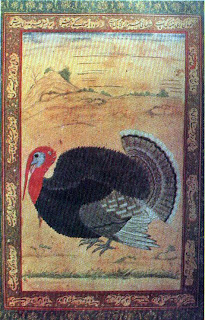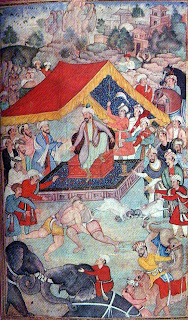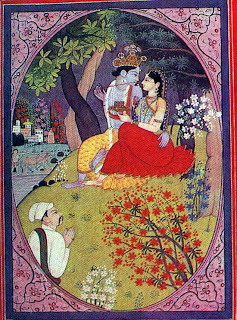 The
southern style with strong Vijayanagara influences is noticed in the Schools of
Ahmednagar, Golconda and Bijapur. The quarrels of these three states with the
neighboring empire of Vijayanagara at least helped mutual migrations of culture
and the adoption of ideals in painting.
The
southern style with strong Vijayanagara influences is noticed in the Schools of
Ahmednagar, Golconda and Bijapur. The quarrels of these three states with the
neighboring empire of Vijayanagara at least helped mutual migrations of culture
and the adoption of ideals in painting.
Visitors
to Hampi, the old capital of the Vijayanagara empire, can never miss the
beautiful blend in a gentle vein of Muslim art in the architectural forms of
some of the buildings composing the adjuncts of the ruined series of royal
mansions in the capital. The admixture is pleasing and unobtrusive as in the
queen's bath and the lotus mahal.
The
proximity of the Vijayanagara empire to the Sultanates of Bijapur, Ahmednagar,
Golconda and Bidar has not been without perceptible mutual influences in art.
It is the Deccani idiom from Ellora that is noticed in the West Indian Jain
texts from Gujarat. It is the same idiom that is noticed in the region of the
Gajapati of Orissa whom Krishnadevaraya conquered abouts A.D. 1515. If the
influences of the Gujarati school of text illustrations produced an effect even
in distant Mewar and Malwa, the effect of Vijayanagara painting in the
neighboring Bahmani kingdoms was quite natural. From the Muslim side,
influences from Malwa also filtered down to the Bahmani area.
In Malwa
as in the Mughal court in Delhi, Persian influences held sway. The Sultans of
Malwa like Nasiruddin Khilji encouraged Persian artists in their court who
produced illustrated books like the Bustan of Sadi. In these paintings there is
a marked element of the Persian mode enlivened by indigenous Hindu elements as
in books like Nimat Nama and Laur Chanda.
 The
southern style with strong Vijayanagara influences is noticed in the Schools of
Ahmednagar, Golconda and Bijapur. The quarrels of these three states with the
neighboring empire of Vijayanagara at least helped mutual migrations of culture
and the adoption of ideals in painting.
The
southern style with strong Vijayanagara influences is noticed in the Schools of
Ahmednagar, Golconda and Bijapur. The quarrels of these three states with the
neighboring empire of Vijayanagara at least helped mutual migrations of culture
and the adoption of ideals in painting.
Krishnadevaraya's
conquest of Kapilesvara Gajapati and his marriage to the Orissan princess
brought Kalinga, which had long before been under Eastern Chalukyan influence,
again under the influence of a victorious emperor of the south, which no doubt
has resulted in such pictures as compose the illustrations of the Gitagovinda
from Orissa, with a little text of Jayadeva to enliven the painting, which
forms the principal element of the page.
This
style, reinforced by a touch of the Mughal during its decadent period when the
artists at the imperial court dispersed in different directions, produced a new
variety which prevailed as the Deccani version of Mughal art in the south.
Local
patronage in centres like Hyderabad, Cuddapah, Kurnool, Arcot, Mysore and
Tanjavur accounts for sub-schools in all these areas. Under the Maratha kings,
the Tanjavur school developed an art not only of book illustration but also of
painting on cloth, mounted on board, with the use of paste for producing the
effect of slight modeling in relief and the arrangement of semi-precious stones
and gold leaves for decorating the ornaments of figures that composed groups
illustrating famous scenes from the epics and the Puranas, particularly the
Ramayana and the Krishnalila, as well as portraits of the Maratha rulers and
the nobility at the court. Some of the most beautiful portraits are known among
the paintings of this period but have not been sufficiently made available for
study.
The
effect of the European mode of paintings on the Indian could already be noticed
in the pictures of the late eighteenth and nineteenth centuries and a distinct
Indo-Anglian style of painting may also be discerned all over the country.
The
introduction of the western style of oil painting and the teaching of it to
earnest Indian students by some of the European masters themselves resulted in
such brilliant painters as Raja Ravi Varma who, coming from the princely family
of Travancore, with a profound knowledge of Sanskrit, a wonderful cultural
background and with the mastery of the technique of the Western mode, produced
at a rapid pace an amazing number of pictures illustrating every possible text
in Sanskrit, revealing his brilliance in art and literature, in addition to his
eminence as a portrait-painter. But in the early years of the twentieth century
it was soon realized, at the call of Havell, by a young gifted painter from the
Tagore family, Abanindranath that this trend in painting cut the Indian painter
away from the past. He, therefore, sought to go back to the classical age and
recapture the glory of the earlier artists, as at Ajanta and Bagh. Among the
earliest to copy the paintings at Ajanta and Bagh are his famous pupils
Nandalal Bose, A.K. Haldar, S.N. Gupta and others. This new revival brought a
change in outlook for a time. But the trend in art today is running after the
Impressionist, Futurist, Cubist, Surrealist and other modes of experimentation
in modern art in the West which probably also takes our artists away from their
moorings. The hereditary craftsman and painter still earns a precarious
livelihood as a bazaar artist executing cheap pictures to satisfy the demand of
pilgrims visiting holy places where the bazaars have a sprinkling of them
catering to their needs, from distant jagannathapuri and Nathadvara in the
north to Tirupati and Ramesvaram in the south.
Writer Name: C. Sivaramamurti
Subscribe to:
Post Comments (Atom)













0 Response to "Deccani and Allied Schools"
Post a Comment